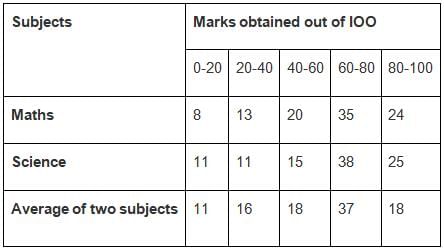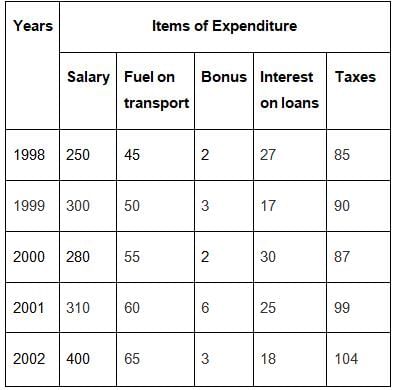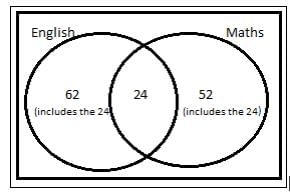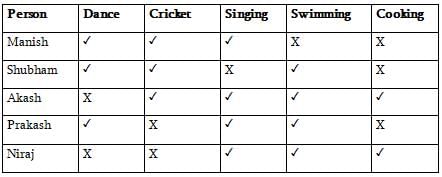APSC CCE Prelims (Paper 2) Mock Test - 2 - APSC CCE (Assam) MCQ
30 Questions MCQ Test - APSC CCE Prelims (Paper 2) Mock Test - 2
In which direction is A from B?
Statement- (1) C is in the South from B which is in the West of A.
Statement- (2) B and D is in a straight line and D is in the South from A.
In a poor country like India, as income rises people first concentrate on increasing their consumption of what they regard as basic or more essential consumer goods. For the poor, these goods would primarily include cereals and for people at successive levels of higher income protective foods, simple non-food consumer goods, more modern, better quality non-food consumer goods and simple consumer durables, better quality consumer goods, and so on. When the demand for basic and more essential consumer goods is more or less met, demand for the next higher level of consumer goods begins to impinge on consumer decision making and their consumption increases. There is thus a hierarchy of income levels and a hierarchy of consumer goods. As incomes rise and one approaches the turning point referred to, there is an upward movement along the hierarchy in the demand for consumer goods which exhibits itself in a relative increase in the demand for these goods. If one examines the past consumption behaviour of households in India, one finds confirmation of the proposition just made. Until the mid seventies one notices a rise in the proportion of consumption expenditure on cereals, and thereafter, a steady decline reflecting a progressive increase in the relative expenditure on non-cereal or protective foods. About the same time the rising trend in the share of food in total consumption expenditure also begins to decline, raising the proportion of expenditure on non-food consumer goods. Simultaneously one also notices a sharper rise in the proportion of expenditure on consumer durables. Thus, what one sees is an upward movement in consumer demand along the hierarchy of consumer goods which amounts to a major change in consumer behaviour.
Prices of protective food have risen because
Out of 130 students appearing in an exam, 62 failed in Science, 52 failed in English, whereas 24 failed in both Science and English. The number of students who passed is
Scholars argued that "the curriculum, while loud on rhetoric, fails to address the equality of education that students of underprivileged and marginalized groups experience." Several other critics described the revised curriculum as a retrogressive step in education that sought to impose the religious agenda in the garb of a national identity. The subsequent change of national government in 2004 led to the curriculum review in 2005, underlining a new political interest in the role of education in national development, its role in social mobilization and transformation directed specifically at questions of caste and gender asymmetry and minority empowerment. Deeper than these politically driven initiatives, however, the professional need for curriculum review emerges from the long ossification of a national education system that continues to view faculty as "dispensers of information" and students as "passive recipients" of an "education" sought to be "delivered" in four-walled classrooms with little scope to develop critical thinking and understanding.
What hampers the critical thinking ability of college-going students?
Direction for: Each of the following questions is based on the following information:
1. Six flats on a floor in two rows facing North and South are allotted to P, Q R, S, T and U.
2. Q gets a North facing flat and is not next to S.
3. S and U get diagonally opposite flats.
4. R next to U, gets a south facing flat and T gets North facing flat.
If the flats of P and T are interchanged then whose flat will be next to that of U?
A wine seller had three types of wine. 435 litres of 1st kind, 609 litres of 2nd kind and 290 litres of 3rd kind. Find the least possible number of casks of equal size in which different types of wine can be filled without mixing.
Directions: The following table shows the marks obtained by 100 students in Mathematics, Science and the average of the two subjects.

Find the number of students who got 60% or more marks in both subjects.
Milankovitch proposed in the early twentieth century that the ice ages were caused by variations in the Earth’s orbit around the Sun. For some time, this theory was considered untestable, largely because there was no sufficiently precise chronology of the ice ages with which the orbital variations could be matched. To establish such a chronology, it is necessary to determine the relative amounts of land ice that existed at various times in the Earth’s past. A recent discovery makes such a determination possible: relative land-ice volume for a given period can be deduced from the ratio of two oxygen isotopes, 16 and 18, found in ocean sediments. Almost all the oxygen in water is oxygen 16, but a few molecules out of every thousand incorporate the heavier isotope 18.
When an ice age begins, the continental ice sheets grow, steadily reducing the amount of water evaporated from the ocean that will eventually return to it. Because heavier isotopes tend to be left behind when water evaporates from the ocean surfaces, the remaining ocean water becomes progressively enriched in oxygen 18. The degree of enrichment can be determined by analyzing ocean sediments of the period, because these sediments are composed of calcium carbonate shells of marine organisms, shells that were constructed with oxygen atoms drawn from the surrounding ocean. The higher the ratio of oxygen 18 to oxygen 16 in a sedimentary specimen, the more land ice there was when the sediment was laid down.
According to the passage, which of the following is true of the ratios of oxygen isotopes in ocean sediments?
Direction: A, B, C, D, E, F, G and H members of the family. Sitting around a table facing the center. There are 3 generations and there are 2 married couples and the rest are children of the 2nd generation. A the grandchild of E sits immediate right to his grandmother D. B and G, daughters of C sit between their parents. H the son of F but F is not his mother, sits between his sister and his mother and he is immediately right to his mother. A’s mother is sitting between her only son and one daughter G.
How H related to E?
If the 1st day of a century is Friday then what could be the 1st day of the next century.
Statement:
A. Daily soap for women is generally senseless.
B. Women love to watch daily soap.
Conclusions:
1. Women are senseless.
2. All daily soaps are senseless.
Adam, Boris and Khan start from the same place and travel in the same direction at speeds of 15, 30 and 60 km per hour respectively. Boris starts two hours after Adam. If Boris and Khan overtake Adam at the same instant, how many hours after Adam did Khan start?
if the HCF of two numbers (each greater than 15) be 15 and LCM be 315, then the sum of numbers will be
Ganguly has a certain average for 4 innings. In the 5th inning, he scores 40 runs thereby increasing his average by 4 runs. His new average is
According to Bruce Hoffman, an American specialist on political violence, old terrorism generally had a specific manifesto-to overthrow a colonial power or the capitalist system and so on. These terrorists were not shy about planting a bomb or hijacking an aircraft and they set some limit to their brutality. Killing so many innocent people might turn their natural supporters off. Political terrorists want a lot of people watching but not a lot of people dead. “Old terrorism sought to change the world while the new sort is often practised by those who believe that the world has gone beyond redemption”, he added. Hoffman says, “New terrorism has no long-term agenda but is ruthless in its short-term intentions. It is often just a cacophonous cry of protest or an outburst of religious intolerance or a protest against the West in general and the US in particular. Its perpetrators may be religious fanatics or diehard opponent of a government and see no reason to show restraint. They are simply intent on inflicting the maximum amount of pain of the victim.”
The sole objective of the old terrorism, according to Hoffman, was to
From ‘apparel to aerospace’, ‘steel to software’, the pace of technological innovation is quickening. No longer can companies afford to miss generation of technology and expect to remain competitive. Adding to the pressure, innovations are increasingly crossing industry boundaries; a new fibre developed by the textile industry has potential for building materials and medical equipment. Some companies are adept at using a diversity of technologies to create new products that transform markets. But many others are floundering because they rely on a technology strategy that no longer works in such a fast changing environment. The difference between success and failure is not how much a company spends on research and development
(R&D), but how it approaches it. There are two possible approaches. Either a company can invest in R&D that uses an older generation of technology, the ‘breakthrough’ approach-or its focus on combining existing technologies into hybrid technologies - the ‘technologies fusion’ approach. It blends incremental technical improvements from several previously separate fields of technology to create products that revolutionise markets. In a world where the old maxim ‘one technology one industry’ no longer applies, a singular breakthrough strategy is inadequate; companies need to include both the breakthrough and fusion approaches in their technology strategy. Relying on breakthroughs alone fails because it focuses the R&D efforts to narrowly, ignoring the possibilities of combining technologies. Yet many western companies still rely almost exclusively - on the breakthrough approach. The reasons are complex: a distrust of outside innovations and not-invented here engineering and arrogance and aversion to sharing research results.
What, according to the author, is adding to the pressure on the companies?
Directions: Study the following information carefully and answer the questions that follow.
Manish and Shubham are good in Dance and Cricket. Akash and Manish are good in Cricket and Singing. Akash, Prakash and Niraj are good in Singing and Swimming. Niraj and Akash are good in Singing and Cooking. Prakash and Shubham are good in Swimming and Dance.
Who is good in Singing, Swimming and Cooking but not in Cricket?
It is an old saying that knowledge is power. Education is an instrument which imparts knowledge and, therefore, indirectly controls power. Therefore, ever since the dawn of civilization persons in power have always tried to supervise or control education. It has been the handmaid of the ruling class. During the Christian era, the ecclesiastics controlled the institution of education and diffused among the people the gospel of the Bible and religious teachings. These gospels and teachings were no other than a philosophy for the maintenance of the existing society. It taught the poor man to be meek and to earn his bread with the sweat of his brow, while the priests and the landlords lived in luxury and fought duels for the slightest offense.
What do you mean by the “sweat of his brow”?
Directions: Study the following graph carefully to answer the questions given below it.
Production of Wheat (in Lakh tonnes) by three different countries America, Britain & Canada over the years is 51.66 , 43, 30.83 respectively.
What is the difference (in Lakh tonnes) between the average production per year of the country with highest average production and that of the country with the lowest average production?
Direction for: Each of the following questions is based on the following information:
1. Six flats on a floor in two rows facing North and South are allotted to P, Q R, S, T and U.
2. Q gets a North facing flat and is not next to S.
3. S and U get diagonally opposite flats.
4. R next to U, gets a south facing flat and T gets North facing flat.
Which of the following combinations get south facing flats?
A, B and C have the money in ratio 3: 4: 5, if B gives 400 to C the ratio of amount A, B and C have becomes 5: 6: 9. Find the initial total amounts that A, B and C have?
There is a Hockey match of Dhyanchand tomorrow, at Motera stadium. In recent years, it has rained only 73 days each year. Unfortunately, the weatherman has predicted rain for tomorrow. When it actually rains, the weatherman correctly forecasts rain 80 of the time. When it doesn't rain, he incorrectly forecasts rain 20 of the time. What is the probability that it will rain on the day of Dhyanchand's Hockey match?
According to Bruce Hoffman, an American specialist on political violence, old terrorism generally had a specific manifesto-to overthrow a colonial power or the capitalist system and so on. These terrorists were not shy about planting a bomb or hijacking an aircraft and they set some limit to their brutality. Killing so many innocent people might turn their natural supporters off. Political terrorists want a lot of people watching but not a lot of people dead. “Old terrorism sought to change the world while the new sort is often practised by those who believe that the world has gone beyond redemption”, he added. Hoffman says, “New terrorism has no long-term agenda but is ruthless in its short-term intentions. It is often just a cacophonous cry of protest or an outburst of religious intolerance or a protest against the West in general and the US in particular. Its perpetrators may be religious fanatics or diehard opponent of a government and see no reason to show restraint. They are simply intent on inflicting the maximum amount of pain of the victim.”
According to the author of the passage, the root cause of terrorism is
1. Religious fanaticism
2. socio-political changes in countries
3. The enormous population growth
In a college, 12% of total students are interested in chess. 3/4 of the total students are interested in hockey. 10 % of the remaining students are interested in singing and the remaining 117 are interested in dancing. How many students are there in college?
Study the following table and answer the question based on it.

Expenditures of a Company (in Lakh Rupees) per Annum Over the given Years
The total amount of bonus paid by the company during the given period is approximately what percent of the total amount of salary paid during this period?
In an exam of two papers maths and chemistry, 60% of the students pass in maths and 70% pass in chemistry. What is minimum percentage of students who could have failed in both the subjects?
In the eighteenth century, Japan’s feudal overlords, from the shogun to the humblest samurai, found themselves under financial stress. In part, this stress can be attributed to the overlords’ failure to adjust to a rapidly expanding economy, but the stress was also due to factors beyond the overlords’ control. Concentration of the samurai in castle-towns had acted as a stimulus to trade. Commercial efficiency, in turn, had put temptations in the way of buyers. Since most samurai had been reduced to idleness by years of peace, encouraged to engage in scholarship and martial exercises or to perform administrative tasks that took little time, it is not surprising that their tastes and habits grew expensive. Overlord’s income, despite the increase in rice production among their tenant farmers, failed to keep pace with their expenses. Although shortfalls in overlord’s income resulted almost as much from laxity among their tax collectors as from their higher standards of living, a misfortune like a fire or flood, bringing an increase in expenses or a drop in revenue, could put a domain in debt to the city rice-brokers who handled its finances. Once in debt, neither the individual samurai nor the shogun himself found it easy to recover. It was difficult for individual samurai overlords to increase their income because the amount of rice that farmers could be made to pay in taxes was not unlimited, and since the income of Japan’s central government consisted in part of taxes collected by the shogun from his huge domain, the government too was constrained.
According to the passage, the major reason for the financial problems experienced by Japan’s feudal overlords in the eighteenth century was that
Despite the best efforts of those responsible for preventing fraud, one inevitable reality remains: “fraud happens.” Because fraud and misconduct can occur at various levels in any organization, it is essential that appropriate preventive and detective techniques are in place. Although fraud prevention and detection are related concepts, they are not the same. While prevention encompasses policies, procedures, training, and communication, detection involves activities and programs designed to identify fraud or misconduct that is occurring or has occurred. Although preventive measures cannot ensure that fraud will not be committed, they are the first line of defence in minimizing fraud risk. One key to prevention is making personnel throughout the organization aware of the fraud risk management program, including the types of fraud and misconduct that may occur. This awareness should enforce the notion that all of the techniques established in the program are real and will be enforced. The ongoing communication efforts could provide information on the potential disciplinary, criminal, and civil actions that the organization could take against the individual. With this in mind, prevention and deterrence are interrelated concepts. If effective preventive controls are in place, working, and well-known to potential fraud perpetrators, they serve as strong deterrents to those who might otherwise be tempted to commit fraud. Fear of getting caught is always a strong deterrent. Effective preventive controls are, therefore, strong deterrence controls.
What is the strong deterrent for fraud according to this passage?
Excluding stoppages, the speed of a bus is 54 kmph and including stoppages, it is 45 kmph. For how many minutes does the bus stop per hour?

























